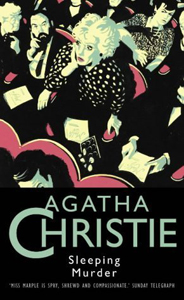“Sleeping Murder” (October 1976), which Agatha Christie (1890-January 1976) wrote mid-career with the purposeful intent of having it published after her death, is like a final exam for readers. But if you’ve read all her works before this, it’s the easiest and most enjoyable final exam you’ll ever have.
Lesson one, as Miss Marple reminds her amateur co-sleuths – young spouses Gwenda and Giles – is to not trust what people say. Only trust what can be proven. Trusting what people say in “Sleeping Murder” will lead you in one direction; following the facts will lead you in another.
It’s so well-written, though, that even armed with this knowledge you might not figure out the solution. I paused a little before the grand finale and purposely sat with my thoughts, Poirot-style. I correctly guessed whodunit, although I didn’t figure out all the wrinkles of how the person pulled off each step.

“Sleeping Murder” (1976)
Author: Agatha Christie
Genre: Cold-case mystery
Series: Miss Marple No. 13
Setting: Dillmouth, England, 1945
As such, “Sleeping Murder” achieves the best of both worlds: I solved it, but not because I outsmarted Christie. Rather, it’s because I applied her lessons.
Cracking the cold case
At the same time as “Sleeping Murder” is a smart novel with a twisty plot and multiple well-developed suspects and witnesses, it’s also a rather relaxing story, as opposed to an intense and urgent one. Joining Poirot’s “Five Little Pigs” and Tommy and Tuppence’s “By the Pricking of My Thumbs,” this is Marple’s cold case novel.
That’s not to say there isn’t an intriguingly vague danger, as Marple warns Gwenda and Giles about digging up the past. They might not like what they find. What’s worse, they might awaken the murderer.
Eighteen years before, Gwenda (then a baby) had seen a murder committed in the Dillmouth house she and her husband have now purchased – either by coincidence or by the universe’s sense of balance. Gwenda thinks the victim was her stepmother, who officially left town around that time but generally disappeared off the face of the earth – although letters to a relative suggest she was not murdered.
Christie sometimes got titles in her head before attaching them to specific novels. The phrase “murder in retrospect” is used a couple times in this novel, but that had become the alternate title of “Five Little Pigs.” “Sleeping murder” is another way of saying the same thing.
Rules of ‘Thumbs’
The tie-in to “By the Pricking of My Thumbs” is even more overt. A key character from that novel makes a cameo here, thus placing “Sleeping Murder” before that book chronologically. The pop-in will be an eye-opener for people who have read “Thumbs,” and a meaningless oddity for those who haven’t.

But the connection between the novels is still more extreme. Christie said she wrote “Thumbs” as a thank-you to T&T fans, which suggests she wasn’t as creatively driven as other times. Still, I did give that novel a high grade, as I loved the idea of peering into the past – interviewing old witnesses and piecing a puzzle together.
Now I realize Christie was – consciously to a degree, but perhaps more extremely than she should’ve – rewriting “Sleeping Murder,” which she had set aside for posthumous publication. But not writing it quite as well as she did the first time.
For one thing, “Sleeping Murder” is deeply personal for Gwenda; the victim is her stepmother, and the chief suspect was her father, who later died. (Gwenda was then raised by relatives in New Zealand.) Tuppence, on the other hand, acts out of sheer curiosity (which admittedly fits her character).
Also a knock against “Thumbs”: It drifts into wider conspiracies, whereas “Sleeping Murder” stays focused on the core group of characters and their personal motivations. “Thumbs” has a greater sense of horror mood, but “Sleeping Murder” does maintain its own mild sense of danger.
Rest in peace
“Sleeping Murder” is less appreciated than “Curtain” – which Christie also wrote mid-career, then had it published in 1975, when she had retired. That’s understandable. “Curtain” says so much about Poirot in his unambiguously final outing. It’s a reminder of why we love the character, but it has a twist.
This is the last-published Marple novel, but chronologically it is in the middle, and it doesn’t tell us anything new about her. But she is in her prime, at the top of her game – giving out lessons but not holding Gwenda’s (or the readers’) hand. Judged as a mystery with tricky but solvable clues, this is an elite entry. In plausibility, I rank it ahead of “Curtain.”
At any rate, “Sleeping Murder” is our last piece of Marple writing from Christie, a gift from the beyond. It’s like the twinkle in both character’s and author’s eyes is perpetual.
Sleuthing Sunday reviews an Agatha Christie book or adaptation. Click here to visit our Agatha Christie Zone.

